How to create competent lighting on the roads. Arrangement of internal driveways and sidewalks
road construction is carried out taking into account the natural climatic conditions, depending on which is divided into five zones: I- permafrost II- excess moisture III- variable humidification, IV- inadequate hydration V- dry.
The durability of roads is determined by the design and materials used, their choice should be made taking into account the expected traffic intensity, climatic and soil-geological conditions, microrelief and the presence of local building materials(see table).
Streets and roads may have the following main elements: carriageways, sidewalks, pedestrian roads, bike paths, strips of green spaces, dividing strips, slopes of embankments and cuts, roadsides and ditches open system drains, retaining walls, technical and reserve lanes, stops public transport, car parks. The boundaries of streets and roads are red lines, which determine their width.
Strips of green spaces are used to separate the carriageway from sidewalks, as well as sidewalks from buildings. Technical lanes are provided for the laying of underground engineering networks, reserve lanes - for the subsequent expansion of the carriageway or the reconstruction of the street.
The carriageway of streets, roads, squares and driveways must have road clothes.
road clothes consists of the following elements:
coatings(top layer of clothing) of one, two or three layers various materials. A wear layer is often laid on top of the pavement, periodically renewed during the operation of the road;
grounds(bearing part of clothing), ensuring uniform transfer of loads to the underlying layer and subgrade, consisting of one or more layers of different materials:
underlying layer(lower part of clothing), which transfers loads to the subgrade and performs the functions of drainage and thermal insulation.
Pavement structures should be selected with the smallest possible number of stacked layers, allow maximum mechanization of work and the use of local building materials. Imported and scarce materials should be used in minimal quantities, mainly for coating.
Certain requirements for strength are imposed on pavements; coatings must be even, rough and dust-free. Performance roads will largely depend on the chosen pavement design and type of pavement (see table). The strength of pavement is characterized by the equivalent modulus of deformation (modulus of elasticity). In road structures, the moduli of deformation (elasticity) of materials must increase in layers from bottom to top. The rational ratio of the modules of adjacent layers is within 1.5-3.5. The mechanical and thermophysical properties of the base materials and pavement pavement should, if possible, be the same or similar.
When choosing and calculating pavement structures, one can be guided by the approximate characteristics of road construction materials according to the table. .
To determine the equivalent modulus of elasticity of the pavement, data is used (see table).
Most roads, especially on the streets of local traffic and driveways, do not require pavement capital type. Pavement structures can be made using local materials and industrial waste. In rural settlements, it is advisable to pave roads from mineral materials treated with bitumen on the road, and pavement pavements - from piece materials. Recommended types of pavement structures for rural settlements in various natural and climatic zones are presented in fig. 1, 2, 3.
Roads made of stone make two types - individual block stones and cobblestone concrete slabs hexagonal shape. The second type deserves special attention, since the construction of such roads allows work to be carried out by industrial methods and does not require highly qualified workers to trim and fit individual block stones.
The use of concrete slabs for pavement should be wide use, as this allows you to make sidewalks prefabricated and save the slabs (by disassembling the sidewalks) during the laying and repair of underground utilities. In addition, sidewalks made of colored concrete tiles have good view and enliven the street, especially in the presence of green spaces. paving slabs made of gray and pink concrete without reinforcement, rectangular (25 x 12.5 cm) and square (25 x 25), as well as curly - eight, cross, etc. Tiles on sidewalks and boulevards are laid on a concrete or sand base, which top with a solution; the seams between the tiles are sealed with mortar. For the device of the border, rectangular plates with dimensions of 20 x 40 cm and 20 x 80 cm are used.
AT last years in the practice of landscaping buildings began to pay Special attention entrances. For and> design, small-sized vibropressed and pressed small-sized slabs with a decorative cover layer are used (Fig. 4.).
At the same time, there are various options organization of work when laying slabs and for this, appropriate laying schemes have been developed (see table).
The bases of sidewalks are arranged with a thickness of 8 ... 12 cm from cement concrete M 200, crushed stone, gravel, brick battle, shell rock, slag, reinforced soil. Asphalt concrete pavement pavements are made of sandy or fine-grained asphalt concrete in one layer 3-5 cm thick. Engineering networks should not be located under carriageway streets, they are laid in technical strips or landscaping strips and only as an exception under sidewalks.
Electric cables are laid at a depth of 0.6 ... 0.8 m, with several cables they are placed at a distance of 0.15 m from each other. Water supply and sewerage pipes are laid below the estimated depth of soil freezing, taking into account the natural and climatic zone. Along the road, green spaces are created in the form of single-row planting of trees in holes on the sidewalks, row planting of trees on lawn strips, combined row planting of trees and group or row planting of shrubs. Trees are planted at a distance of 2.5 ... 3 m from the curb of the roadway, shrubs at a distance of 1 m. In row planting, the distance between trees should be at least 5 m, between shrubs - 1 m, when creating a two-row hedge - 0, 3-0.5 m. From the outer walls of buildings and structures, trees should be planted at a distance of at least 5 m, shrubs - 1.5 m. Near pedestrian crossings and public transport stops at a distance of 10 m, it is forbidden to plant trees and shrubs with a height of more than 0, 5 m
Rice. 1. Pavement structures with permanent pavements:
a, b, c - for I and II road-climatic zones, d and e - for zones III ... V, 1 - fine-grained asphalt concrete, 2 - coarse-grained asphalt concrete, 3 - cement concrete, 4 - soil, 5 - black crushed stone, 6- crushed stone, 7- sand (gravel-sand mixture)
Rice. 2. Pavement structures with lightweight (a, b) and transitional (c, d) pavements: 1 - double surface treatment, 2 - black crushed stone, 3 - gravel-sand mixture or reinforced soil, 4 - soil, 5 - dense bitumen-mineral mixture, 6 - porous bitumen-mineral mixture, 7 - ordinary crushed stone
Street lighting today is very diverse and multifunctional, in contrast to the internal lighting of residential and non-residential premises. For his proper organization you need to know the norms and requirements, as well as the corresponding GOST, without which it is impossible to evaluate the entire range of factors affecting the outdoor type of illumination.
In street lighting, highway illumination plays an important role, because safety directly depends on it. traffic and the life and health of people. Therefore, there are strict standards and requirements for compliance with GOST parameters in the lighting equipment used.
Lighting highways, especially in cities and urban-type settlements, is the most important element outdoor illumination. Our article will tell you about what norms, requirements and GOSTs exist in this matter, as well as how to correctly select and install lamps on the roads of settlements.
Roadway illumination features
For any city, as well as in smaller settlements, road lighting is an important task. This is primarily due to the fact that the slightest violations on the part of the organization of the lighting system can lead to human casualties.
Note! Lighting of streets and roads is one of the significant factors that ensures the safety of motorists and pedestrians.
Street and road lighting
Therefore, the presence of problems with lighting here (its complete absence, poor quality, violation of norms, GOSTs, etc.) will lead to a sharp increase in potential dangerous situations on the roads and streets of settlements, which often end in tragic consequences.
Therefore, there are strict requirements and norms, as well as its own GOST. All of them are registered in special documentation (SNiP and SanPin). All these norms and GOST must be strictly observed when designing the lighting of roads and highways in settlements. SNiP contains stringent requirements that serve as a guarantee that lighting on the roadway of any settlements will be as efficient and safe as possible.
The role of motorway lighting in cities and villages is reduced to the following tasks:
- full illumination of the roadway in the evening and at night;
- creating the safest conditions for driving on roads and highways;
- lamps placed along the carriageway should give enough level illumination so that drivers, even at night, can clearly see the road and see on it an oncoming car or a pedestrian walking along the side of the road.
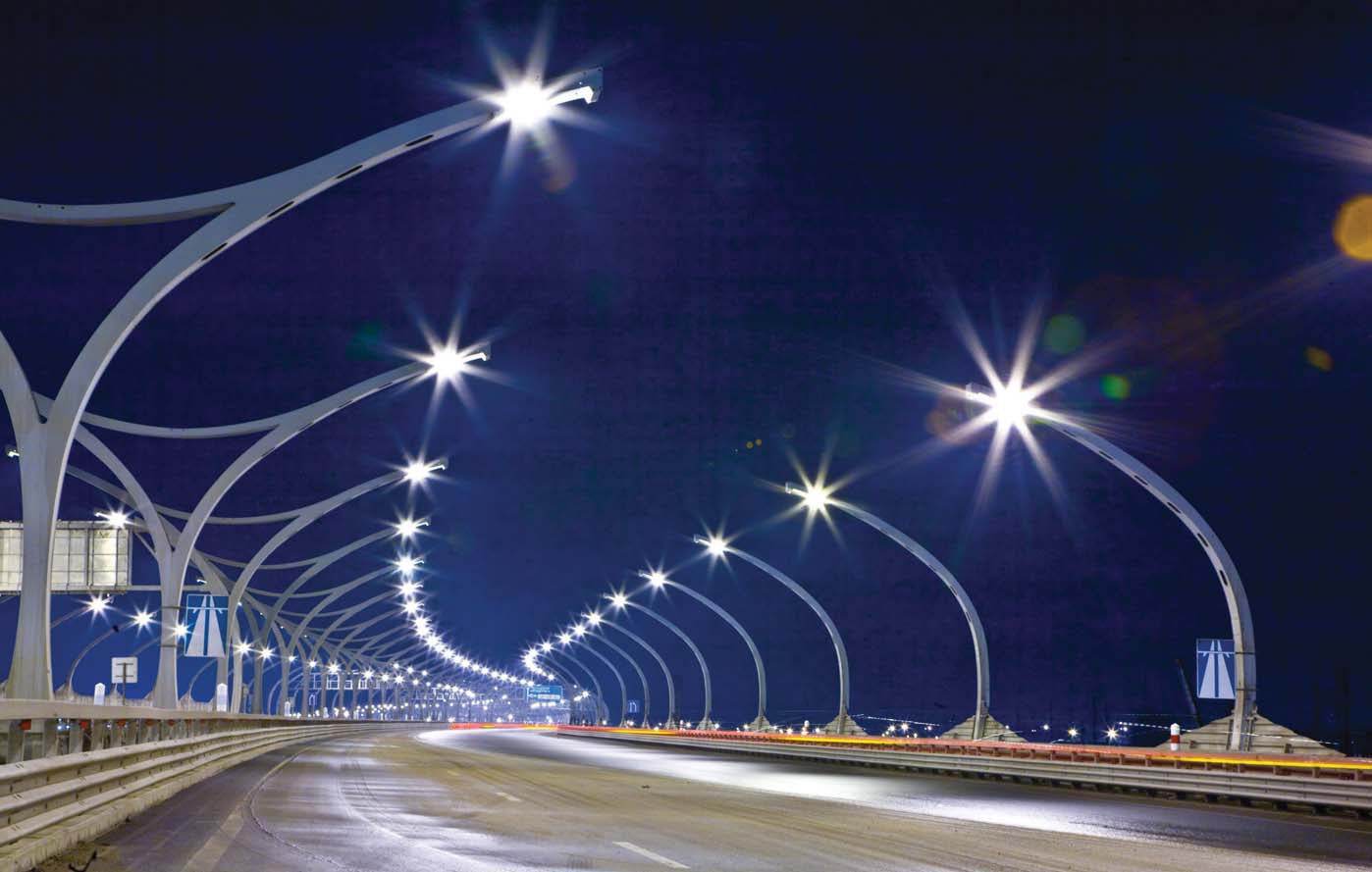
Road lighting at night
In order for the illumination of the roadway in settlements to be sufficient, special calculations are carried out. Here, street lighting relies on several parameters:
- norms and requirements of SNiP that relate to the level of illumination;
- GOST, which is defined for lighting fixtures. All fixtures with fluorescent, LED or halogen lighting must meet the requirements of the relevant GOST;
- power luminous flux which produce light sources (LED, fluorescent or halogen light bulbs).
Note! In the organization of street lighting, a large role is given not so much to lighting fixtures as to their light sources. Light bulbs screwed into lamps should not have a blinding effect and provide more uniform illumination of a specific area on the road.
Road lighting requirements
As noted above, the GOST and the requirements that must be taken into account when creating outdoor lighting on the roads of settlements are spelled out in the regulatory documentation - SNiP and SanPin. And most of all in this situation, you need to rely on the norms and GOST specified in the SNiP. In different sections of these documents, the norms for each specific situation are clearly spelled out.
SNiP itself regulates the required level of illumination, at which drivers have the opportunity to timely and adequately assess the traffic situation. For traffic areas in settlements, it is necessary to calculate the average horizontal illumination. This parameter must be:
- for main roads and streets of regional importance, the average horizontal illumination should be about 6 lm / sq.m;
- for local roads and streets with a transitional type of coating - 4 lm / sq.m;
- if there is another type of coating on the streets and roads - 2 lm / sq.m.
The indicators given above in SNiP guarantee the fact that the driver will be able to distinguish well at a sufficient distance approaching vehicles, as well as all the unevenness of the road surface.
Note! Irregularities and various kinds of flaws on the road can cause an accident.

Road bumps
In addition, the lighting on the roadway should not be very bright, otherwise the luminous flux will blind drivers, which will ultimately lead to an accident.
Thus, the norms and requirements, as well as GOST, make it possible for each individual situation to organize the necessary level of illumination. The luminous flux generated by the lighting system should not be low or excessive. In order to organize street lighting at the optimal level, specific norms are indicated in the SNiP.
Features of the organization of illumination of the roadway
Lighting for roads and streets in the evening and at night is an integral part of modern society.
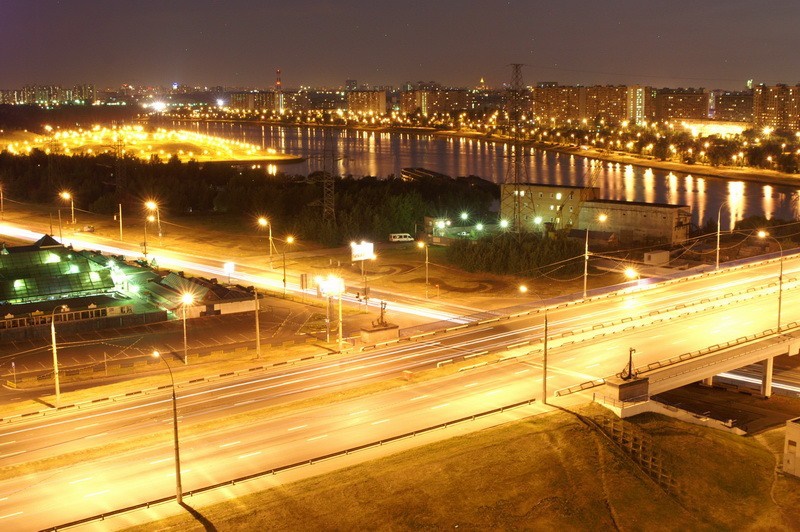
City night illumination
When determining the norms in SNiP, the abilities of the human visual analyzer were taken as the basis. At night, human vision has the ability to adapt to poor visibility and distinguish objects in starlight at an illumination level of 0.1 lux. But in order for a person to be able to comfortably move along the side of the road or ride in a car, the level of illumination created by lighting devices must be at least 2 lux. Therefore, the organization of artificial lighting of highways and roads in settlements is a necessity.
Light in this case must meet the following requirements:
- provide uniform illumination of the roadway. For this, fixtures should be installed at regular intervals, which are prescribed in SNiP;

Uniform placement of lighting poles along the road
- the luminous flux should not be directed to the sky, but to the road;
- full illumination of the space around the moving vehicle, including the roadside and the adjacent lane;
- the presence of a small amount of light flux, which is directed horizontally. Such illumination allows you to increase the visibility distance and the cars driving towards you will be much more noticeable even in the dead of night;
- non-dazzling road lighting.
Note! Much attention in the backlight should be paid on the highway. These roads are for fast driving, so for them it is necessary to create the most comfortable conditions to move vehicles.
When organizing the lighting of roads and highways, luminaires should be installed in certain areas. The number of light points, as well as their location, are determined by the following parameters:
- pavement characteristics;
- purpose of the road (motorway, country road, etc.);
- type of settlement through which the canvas passes (city, village, etc.).
Therefore, the fixtures with which the backlight is formed will differ depending on the specific case:
- for wide roads, lamps should have a power of 250-400 watts;
Note! Main roads, regardless of width, are always best lit. This is due to the fact that they have an increased risk of traffic accidents.
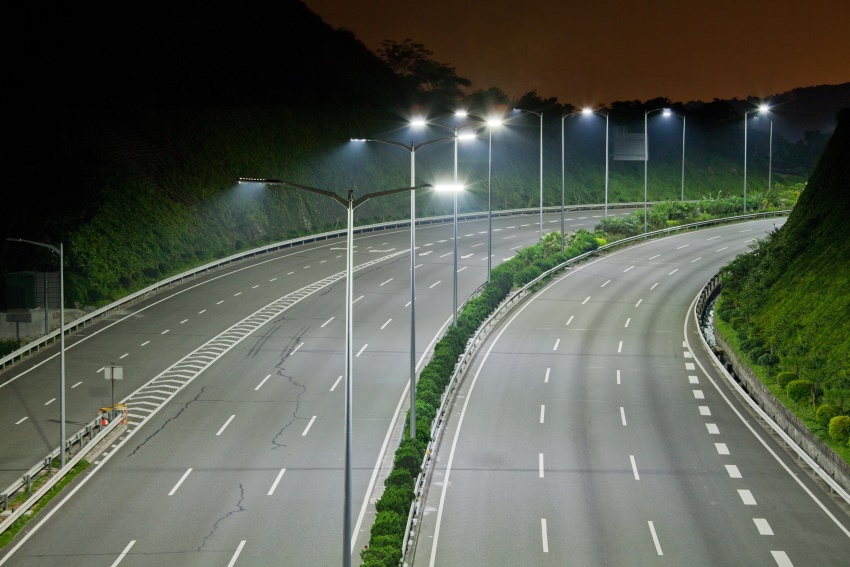
Wide road lighting
- for secondary roads, lamps should have a power of 70-250 watts.
Besides great importance the lamps themselves also play in creating the illumination of the roadway. The safety of movement in settlements depends on their correct choice. Street lighting of settlements will be the more intense, the larger their area.
We select the right lighting fixtures for illuminating the roadway
The quality of street lighting depends on the correct choice of the lamp and its placement. The selection of lighting equipment for roads is regulated by GOST. For an outdoor lighting system, luminaires must meet a number of requirements:

Main lamp
- have a simple and unpretentious service;
- have reliable protection against various climatic conditions (snow, rain, hail, strong gusts of wind, etc.);
- have a high class of moisture protection (at least IP55);
- have anti-vandal protection;
- consume a minimum of electricity and at the same time give a powerful luminous flux;
Note! The most advantageous in all respects today are LED light sources. But due to their high cost, they are often replaced by halogen or fluorescent counterparts.
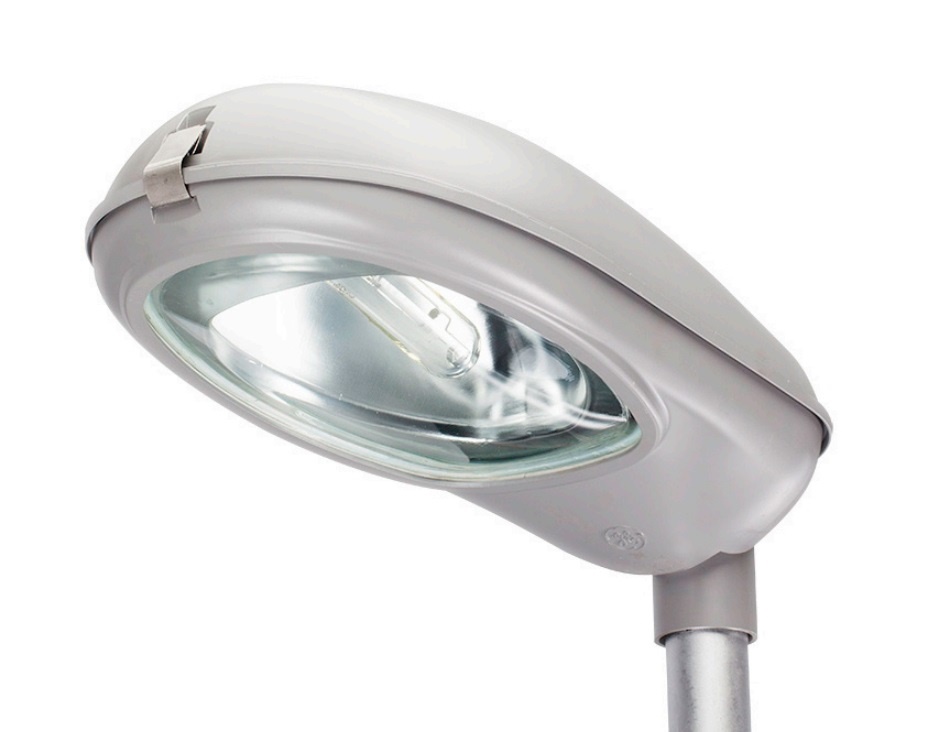
Console lamp
- long service life of both the lamp and light sources;
- have a simple design and blend harmoniously with the supports. This is especially important (from an aesthetic point of view) for city roads:
- the presence of an optical system to create a directional light flux.
The most common lighting fixtures are hanging method fastenings, which allows them to be effectively fixed on the facades of buildings or special supports (cantilever type lamps). The distance between the posts should be 50 meters, and their height can vary from 5 to 12 meters, depending on existing needs.
Conclusion
It is necessary to approach the lighting of roads and highways with a clear understanding that the life and health of people will directly depend on this. Therefore, taking into account the norms, requirements, as well as GOSTs in this situation is a necessity, without which it is impossible. Only in this case the movement Vehicle on the roads will be comfortable and safe, and street lighting will be correct.
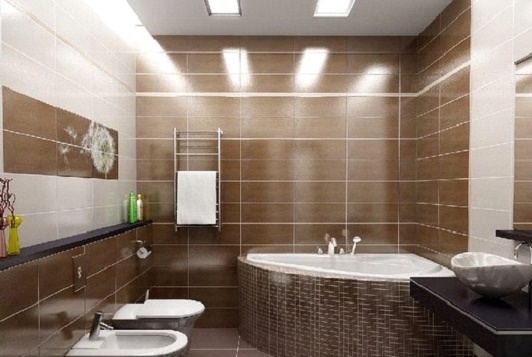 How to do correct lighting for toilet
How to do correct lighting for toilet
font size
DEPARTMENTAL BUILDING REGULATIONS - INSTRUCTIONS FOR ENSURING TRAFFIC SAFETY ON HIGHWAYS - VSN 25-86 (approved - ... Relevant in 2017
Chapter 15. LIGHTING OF ROADS
15.1. To ensure the safety of vehicles and pedestrians, as well as to increase bandwidth roads at night provide stationary lighting installations. When designing them, the following requirements must be observed:
when choosing the type and method of placement of lighting installations, ensure the illumination of roads in accordance with the standards for the average brightness of the carriageway and the average horizontal illumination of roadsides and sidewalks: uniformity of the distribution of brightness (the ratio of the maximum brightness at certain points of the carriageway to the minimum); blindness indicator;
Identify and emphasize the location of dangerous zones (crossings and junctions, narrowing roads, pedestrian crossings, bus stops) by changing the color of light sources, placing supports and lamps, increasing the brightness of the roadway in the danger zone;
ensure the visual orientation of drivers on the way due to the rational placement of supports and lamps, changing the color of light sources on adjacent roads, limiting the disorienting effects of advertising lights, shop windows and security lighting of objects located near the road;
Avoid sudden changes in illumination in front of complex and dangerous sections of roads and alternation of illuminated and unlit areas, arranging continuous lighting when illuminated sections of the road are located at a distance of less than 250 m from each other;
achieve a smooth decrease in the brightness of the roadway at the exit from the illuminated section to the unlit one, arranging a transition zone 150-250 m long;
strive to use such elements of lighting installations that meet the requirements of aesthetics and do not violate the appearance of the architectural ensemble of the road and the structures located on it;
Avoid placing lighting poles on those elements of roads and intersections where their installation may cause traffic accidents;
use supports that do not provide much resistance to shear when a car hits.
15.2. Stationary lighting on highways should be provided for:
in settlements (according to SNiP II-4-79, part II, chapter 4. Design standards. Natural and artificial lighting);
On medium and large bridges (overpasses) in accordance with the recommendations of Table. 15.1;
Table 15.1
| Bridge (overpass) length, m | The length of the cable line from the power supply point to the illuminated object, km | Initial traffic intensity, thousand cars/day, at which the lighting device is justified for the annual increase in traffic intensity, % | ||
| 5 | 10 | 15 | ||
| 50-100 | 1 | 8,0 | 4,0 | 2,0 |
| 5 | 12,5 | 7,5 | 6,0 | |
| 10 | 18,5 | 13,0 | 9,0 | |
| 100-200 | 1 | 5,0 | 2,5 | 1,0 |
| 5 | 9,5 | 5,0 | 1,5 | |
| 10 | 12,5 | 8,0 | 4,5 | |
| Over 200 | 1 | 4,5 | 2,5 | 1,0 |
| 5 | 7,5 | 3,5 | 1,5 | |
| 10 | 10,0 | 5,0 | 2,5 | |
Notes. 1. The table shows the initial traffic intensity on two-, three-lane roads. For four-lane roads with a dividing strip, it should be increased by 1.5 times compared to the table values, and for six-lane roads - by 2 times. 2. Intermediate values may be determined by interpolation.
on the petrol stations and in areas where traffic service complexes are located;
at intersections of roads of categories I and II with each other at one and different levels, as well as at all connecting branches of intersections at different levels and at approaches to them at a distance of at least 250 m from the beginning of the transitional speed lanes;
at railway crossings (in accordance with the Instructions for the Arrangement and Maintenance of Crossings);
in transport road tunnels on roads of categories I and II and on approaches to them at a distance of at least 150 m from the beginning of the tunnel;
in pedestrian tunnels, on stairways and platforms in front of tunnel entrances;
under overpasses, on roads of categories I-III, if the length of the passage under them exceeds 30 m;
At bus stops, underground pedestrian crossings, in areas of traffic accidents at night at clubs, cinemas and other places of concentration of pedestrians located near the road in settlements where there is no street lighting, at a distance to power supply sources of no more than 2 km, taking into account the requirements of the State traffic inspectorate.
15.3. Outside settlements, the average brightness of the carriageway of roads and bridges (overpasses) should be: 0.8 cd / m2 on roads of category I; 0.6 cd/m2 on category II roads; 0.4 cd/m2 - on connecting branches of intersections at different levels. The average horizontal illumination of roadsides should not be lower than: 8 lux on category I roads; 6 lux on category II roads; 4 lux - on connecting branches of intersections at different levels. The average horizontal illumination of sidewalks of bridges (overpasses) is taken in accordance with the norms for lighting sidewalks in settlements (according to SNiP II-4-79).
The ratio of the maximum brightness of the carriageway to the minimum should be no more than 3:1 on category I roads and 5:1 on other roads. The ratio of the maximum illumination of the curb to the average should be at a rate of average illumination of 6-8 lux no more than 3:1, and at 4 lux no more than 5:1.
The illumination standards for road tunnels and passages under overpasses (more than 60 m long) are adopted according to SNiP II-44-78. The average horizontal illumination of passages under overpasses (bridges) should be at least 15 lux, and the ratio of maximum illumination to the average should not exceed 3:1. The glare index of outdoor lighting installations should not exceed 150.
15.4. Lamp supports are usually installed behind the edge of the subgrade at a distance of at least 0.5 m from it. On embankments up to 3 m high, powder berms with dimensions of 2 x 2 m are arranged for the installation of supports. With a higher embankment height and the presence of stable support slopes installed on piles 5-6 m long with a cap (Fig. 15.1, a). In heaving soils and in areas of permafrost, supports are installed in pits, fenced with wooden boxes (Fig. 15.1, b), filling the sinuses in the upper part with draining soil. In exceptional cases (on embankments with a height of more than 3 m in the presence of unstable slopes of the subgrade, on sections of roads where the placement of supports is prevented by cable or overhead communication lines and power transmission lines), it is allowed to install supports on the side of the road or the dividing strip (with their width of at least 3 m) .
Rice. 15.1. Schemes for embedding lighting poles in the ground: a - under favorable soil conditions; b - in heaving soils; 1 - support; 2 - head; 3 - pile; 4 - wooden box
If the width of the dividing strip is 3-4 m, lighting poles should be built into the blocks of the parapet fence or located between them (with the blocks securely fixed to the base using pins, Fig. 15.2, a). With a width of the dividing strip of 5-6 m, the supports can be installed along its axis at a distance of 1.25 m from the support to the guide bar of the fence (Fig. 15.2, b).
On roadsides, supports are installed at the edge of the subgrade at a distance of no more than 0.5 m from it, providing for a fence. The distance from the guide bar of the fence to the support must be at least 1.25 m, and from the bar to the edge of the carriageway, at least 1 m (Fig. 15.2, c). On narrow roadsides, parapet-type fences should be installed at the supports (Fig. 15.2, d).
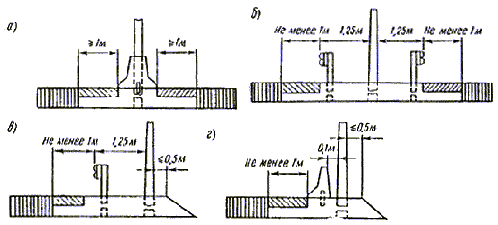
Rice. 15.2. Scheme of installation of lighting poles and fences on the dividing strip (a, b) and the roadside (c, d)
Outside settlements, with an embankment height of up to 2-3 m, it is allowed to install lighting poles on roadsides without fences, if the pole is made of thin-walled steel pipes, and in its lower part (at a distance of 0.4-0.5 m from the curb surface) a flange connection is provided, which is disconnected when a car hits.
On bridges (overpasses), the supports are installed in the railing alignment or behind them in steel cups, and are also fixed with flange joints to the supporting structures of the structure. On bridges with a ride below, it is recommended to fix the luminaires to the structural elements of the structure using brackets or cables (with an axial arrangement of luminaires).
15.5. The road service should pay special attention to maintaining the high reflective properties of road surfaces on illuminated sections of roads, promptly cleaning the carriageway from dirt and ensuring rapid drainage of water from the carriageway. In particularly dangerous places, in all cases, when possible, it is recommended to arrange light rough coatings.





